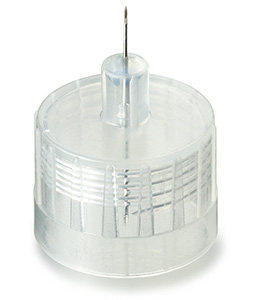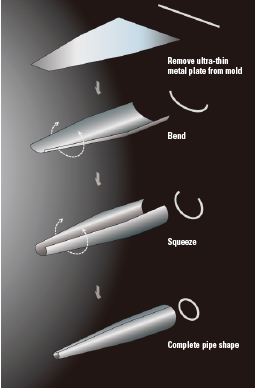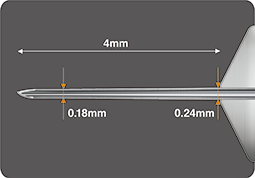December 2022
Needles That Reduce the Pain of Injections

Nanopass Jr., developed for children and other people with thin skin. The needle has a length of 3 mm and outer diameter of 0.18 mm. 
The Nanopass needle manufacturing process 
The Nanopass injection needle has a tapered structure that gets thinner toward the end

A Japanese medical device manufacturer has developed a series of needles that considerably reduce the pain of injections. The needles can make a major contribution in particular to reducing the treatment burden of people with diabetes, who require insulin shots on a daily basis.

Injectors are an essential medical supply for the treatment and prevention of diseases. However, probably most people do not like that tingling pain and would rather avoid injections if they could. Responding to their feelings, Terumo Corporation, a Japanese medical device manufacturer with a history of more than 100 years, has developed the Nanopass series, an injection needle to inject insulin, growth hormone, and so forth.
Nishikawa Hisao, head of the Research & Development Department at Terumo’s Life Care Solutions Division, explains, “I came up with the idea to make a needle that causes less pain when I saw an elementary school student at a hospital injecting insulin by themself. Type 1 diabetesi is a common disease in children as well, requiring 4 to 5 insulin injections a day. I was hoping to lessen the fear of needles that they feel, even by a little.”
Development of the new needle began in 2000. Nishikawa and his colleagues aimed for an injection needle with an outer diameter of 0.20 mm, which is 20% thinner than existing products.

Nishikawa says that “there are 100 to 200 pain receptors per square centimeter distributed on the surface of a person’s skin, so the thinner the needle, the less likely it is to touch pain receptors and create the sensation of pain.” On the other hand, the inner and outer diameters of the injection needle must be structured so that the resistance to injecting the drug does not increase even if the needle becomes thinner. Moreover, in order to reduce the pain at the moment of needle piercing, the tip of the injection needle has an asymmetrical blade structure (asymmetrical edge) with a needle that can “thinly slice” instead of “puncturing” the surface of the skin.
Nishikawa recalls the difficulties at the time, saying, “We consulted with the injection needle manufacturing team within the company and interviewed as many as 100 related companies, but everyone just shook their heads and said that they can’t make such injection needles.” Under these circumstances, the stepping stone to development success was an encounter with Okano Masayuki, a craftsman nicknamed the “Mold Magician.” Okano’s factory in downtown Tokyo, which had only six employees (at the time), possessed the world’s highest level of stamping technology, even taking orders from the National Aeronautics and Space Administration (NASA) and other organizations. After hearing about the hardships of children with diabetes from Nishikawa, Okano decided to lend his hand to this venture into unknown territory.
Working toward being able to produce the world’s thinnest injection needle, it was about one and a half years after the start of development that they came up with a unique method to remove the ultra-thin metal plate from the mold and bend it step by step into a pipe shape. The trial and error process to facilitate mass production with stable quality continued for more than a year.
In 2005, the first product, called the Nanopass 33, reached the market. Since then, research and development have continued, with the Nanopass 34, which has an outer diameter of 0.18 mm, being released in 2012 and the Nanopass Jr., which has the same outer diameter (34G, meaning 34 gauge) but a needle length of 3 mm, debuting in 2019. Nanopass Jr. was developed for children and other people with thin skin. According to Terumo's research (May 2017), the 34G needle is the “world’s thinnest double tapered pen needle.ii” The pursuit of this technology to reduce pain was highly esteemed and received the “Minister of Education, Culture, Sports, Science and Technology Award” and the “Invention Implementation Achievement Award” at the 2021 National Inventors Award.
Nishikawa relates, “When a little girl practicing doing injections with Nanopass at a summer camp for children with diabetes told me that ‘this doesn’t hurt at all,’ I was so happy that I couldn’t hide my delight.”
It is estimated that there are about 1 million people with diabetes who need multiple injections of insulin per day in Japan alone. Needles that cause less pain, created by unprecedented ideas and technologies, will undoubtedly greatly contribute to reducing the treatment burden of people with diabetes not only in Japan but also around the world.

- * A disease in which the cells that produce insulin in the pancreas (β-cells) are destroyed.
- ** The inner and outer diameters get thinner toward the end

